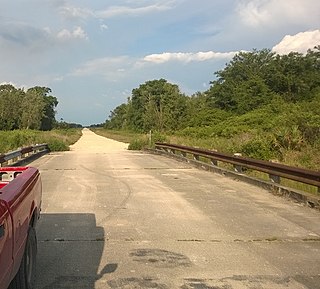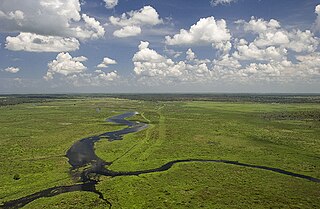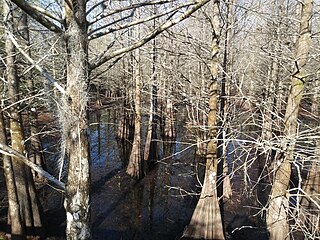Related Research Articles

Everglades National Park is an American national park that protects the southern twenty percent of the original Everglades in Florida. The park is the largest tropical wilderness in the United States and the largest wilderness of any kind east of the Mississippi River. An average of one million people visit the park each year. Everglades is the third-largest national park in the contiguous United States after Death Valley and Yellowstone. UNESCO declared the Everglades & Dry Tortugas Biosphere Reserve in 1976 and listed the park as a World Heritage Site in 1979, and the Ramsar Convention included the park on its list of Wetlands of International Importance in 1987. Everglades is one of only three locations in the world to appear on all three lists.

The Great Dismal Swamp National Wildlife Refuge was created in 1974 to help protect and preserve a portion of the Great Dismal Swamp, a marshy region on the Coastal Plain of southeastern Virginia and northeastern North Carolina between Norfolk, Virginia, and Elizabeth City, North Carolina in the United States. It is located in parts of the independent cities of Chesapeake and Suffolk in Virginia, and the counties of Camden, Gates, and Pasquotank in North Carolina.

The Arthur R. Marshall Loxahatchee National Wildlife Refuge is a 145,188-acre (587.55 km2) wildlife sanctuary is located west of Boynton Beach, in Palm Beach County, Florida. It is also known as Water Conservation Area 1 (WCA-1). It includes the most northern remnant of the historic Everglades wetland ecosystem.

Picayune Strand State Forest is one of 37 state forests in Florida managed by the Florida Forest Service. The 78,000-acre forest consists primarily of cypress swamps, wet pine flatwoods and wet prairies. It also features a grid of closed roads over part of it, left over from its previous land development schemes.

Big Cypress National Preserve is a United States National Preserve located in South Florida, about 45 miles west of Miami on the Atlantic coastal plain. The 720,000-acre (2,900 km2) Big Cypress, along with Big Thicket National Preserve in Texas, became the first national preserves in the United States National Park System when they were established on October 11, 1974. In 2008, Florida film producer Elam Stoltzfus featured the preserve in a PBS documentary.

The Okefenokee National Wildlife Refuge is a 402,000‑acre (1,627 km2) National Wildlife Refuge located in Charlton, Ware, and Clinch Counties of Georgia, and Baker County in Florida, United States. The refuge is administered from offices in Folkston, Georgia. The refuge was established in 1937 to protect a majority of the 438,000 acre (1,772 km2) Okefenokee Swamp. The name "Okefenokee" is a Native American word meaning "trembling earth."

The Florida Trail is one of eleven National Scenic Trails in the United States. It currently runs 1,500 miles (2,400 km), from Big Cypress National Preserve to Fort Pickens at Gulf Islands National Seashore, Pensacola Beach. Also known as the Florida National Scenic Trail, the Florida Trail provides permanent non-motorized recreation opportunity for hiking and other compatible activities and is within an hour of most Floridians. The Florida National Scenic Trail is designated as a National Scenic Trail by the National Trails System Act of 1968.

The Florida Panther National Wildlife Refuge is part of the United States National Wildlife Refuge System, located in southwestern Florida, twenty miles east of Naples, in the upper segment of the Fakahatchee Strand of the Big Cypress Swamp. It is north of I-75 and west of SR 29.
Great Florida Birding and Wildlife Trail (GFBWT) is a 2,000 mile (3200 km) long collection of more than 500 locations in the U.S. state of Florida where the state's bird habitats are protected. The trail promotes birdwatching, environmental education and ecotourism. The GFBWT is a program of the Florida Fish and Wildlife Conservation Commission, supported in part by the Florida Department of Transportation and the Wildlife Foundation of Florida. It is modeled after the successful Great Texas Coastal Birding Trail. Trail sites area identifiable by prominent road signs bearing the Swallow-tailed kite logo.

Silvio O. Conte National Fish and Wildlife Refuge was established in 1997 to conserve, protect and enhance the abundance and diversity of native plant, fish and wildlife species and the ecosystems on which they depend throughout the 7,200,000-acre (29,000 km2) Connecticut River watershed. The watershed covers large areas of Vermont, New Hampshire, Massachusetts and Connecticut. It contains a great diversity of habitats, notably: northern forest valuable as nesting habitat for migrant thrushes, warblers and other birds; rivers and streams used by shad, salmon, herring, the endangered shortnose sturgeon and other migratory fishes; and an internationally significant complex of high-quality tidal fresh, brackish and salt marshes.
Pine Creek Wildlife Management Area is a scientifically managed preserve of natural and native wildlife flora and fauna. It is located in Pushmataha County and McCurtain County, Oklahoma, adjacent to Pine Creek Lake, seven miles north of Valliant, Oklahoma.

Fisheating Creek is a stream that flows into Lake Okeechobee in Florida. It is the only remaining free-flowing water course feeding into the lake, and the second-largest natural source for the lake. Most of the land surrounding the stream is either publicly owned or under conservation easements restricting development. The lower part of the stream remains in a largely natural state, and efforts are underway to restore the upper part of the stream to a more natural state.
Florida Ecological Greenways Network work to provide a "system of native landscapes and ecosystems that supports native plant and animal species, sustains clean air, water, fisheries, and other natural resources, and maintains the scenic natural beauty that draws people to visit and settle in Florida," as stated Florida Greenways Commission. It also functions to devise a plan for a statewide greenways system, based on GIS technology and suggestions from the public. The GIS data used includes soil, water, and geological information, wildlife movements and habitat data, as well as existing trails and parks, transportation and infrastructure fixtures, educational and historical sites, and political boundaries. This system would be created in accordance with the December 1994 report from the Florida Greenways Commission to the Governor of the state of Florida, a report which outlined the protocol for creating it. Such a system would connect all aspects of the state's "green infrastructure", making it more comprehensive for use by the state's citizens and more effective in achieving greater sustainability throughout the state of Florida for generations to come.
The Conservancy of Southwest Florida is an organization located on 21 acres in Naples, Florida, and features the Conservancy of Southwest Florida Nature Center.
Okaloacoochee Slough Wildlife Management Area (WMA) protects 2,992 acres of the larger Okaloacoochee Slough ecosystem approximately 30 miles east of Fort Myers in Hendry County, Florida.

The Six Mile Cypress Slough Preserve is a 3,500 acre wetland, located in Fort Myers, Florida, which filters rainwater on its way towards Estero Bay. The preserve contains a 1.2-mile boardwalk trail, interpretive center, and amphitheater. The slough is a nine mile long, one-third of a mile wide, wildlife corridor, providing a safe way for animals to travel within the Fort Myers city limits. A 57-square-mile watershed drains into the slough.

The Disney Wilderness Preserve is a 11,500-acre nature reserve near Kissimmee, Florida. It was created through an agreement between The Walt Disney Company, The Nature Conservancy, and the state of Florida. It is located fifteen miles south of Walt Disney World.
Campanula floridana, commonly known as the Florida bellflower, is a perennial flowering plant of the family Campanulaceae that is endemic to Florida.
References
- ↑ "Corkscrew Regional Ecosystem Watershed (CREW)". www.sfwmd.gov.
- 1 2 "Our SWAMP TREASURE - Fort Myers Florida Weekly". Fort Myers Florida Weekly -. January 15, 2020.
- ↑ Biro, Elizabeth (January 30, 2023). "CREW protected lands provide snapshot of old Florida, haven for wildlife".
- ↑ "When being sold ten acres of swamp land is a good thing". WGCU PBS & NPR for Southwest Florida. March 10, 2023.
- ↑ https://www.news-press.com/picture-gallery/news/2022/06/26/patience-tinkering-pay-off-photographer-andrew-west-and-his-camera-trap/7741218001/